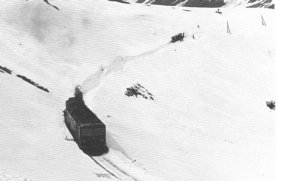
Home | Story | Layout | Construction | Structures | Operation | Fiddle Yard | Pictures | Animations | Links
Snow clearing prior to summer operation
(original pictures by W. Heuberger / Eisenbahn-Amateur 1981)
Every year prior to the opening of the line over the Furka pass, the FO train company had to organise the snow clearing. This job was not only very delicate due to the continuous threat of snow slides and avalanches endangering man and machine but also very expensive: in 1981 the FO had to spend 400’000.- SFr. for the last reopening of the mountain route!
With the line running through the middle of the Alps as high as 2100 m above sea level, the snow is accumulated over the winter months to impressive levels. But the toughest spots where the avalanches were crossing the tracks leaving meter high deposits of snow and ice. Snow walls of 6 m and more were not exceptional.

Due to the depth of the snow, it was not possible to clear the line with train equipment only. The FO used a wheel driven all terrain snow plow for cutting the trench. The worktrain with the rotary plough followed a short distance behind. Its duty was to perform the final clearing down to the tracks and clearing the right profile for the trains. The progession of this group was guided by an experienced line inspector who needed a thorough knowledge of the line and the mountains. He preceeded the wheel driven snowplow on skis and indicated to the driver, with the help of poles, where he had to aim. Depending on how high the snow was piling-up, the snow plow had to make several passages until the trench was deep enough to enable the following rotary plow to do the final track clearing.
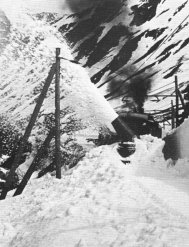
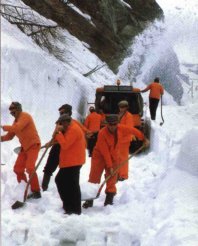
The rotary plow is not self propelling and needs to be supplied with electricity by an external source. Most of the time this is done by one of the two diesel-electric engines HGm 4/4. The power is transmitted via the train heating supply plug. The HGm 4/4 with its two diesel engines driving two generators can be configured so that one generator supplies the driving motors of the engine itself and the other generator supplies the rotary snowplow.
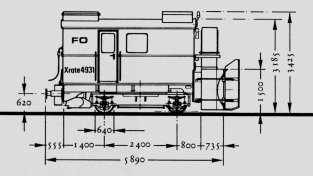
Once the line is cleared of the snow, further work has to be carried out: reinstallation of the catenary where it had been removed, repair of damaged track, rebuilding of the Steffenbach bridge, etc.
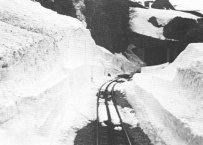
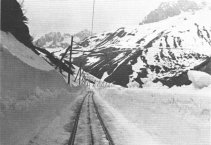
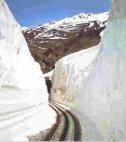
Usualy after 3-4 days of hard work, the line is ready for inspection by the Swiss authorities and a few days later the line is officialy open for its summer operation for the next 4 monthes.

Some more information about this subject can be found on this site. The pictures presented there were taken by one of the engine drivers running the snow clearing train.
Another site showes some pictures of the recent snow clearing of the preserved line.
Home | Story | Layout | Construction | Structures | Operation | Fiddle Yard | Pictures | Animations | Links